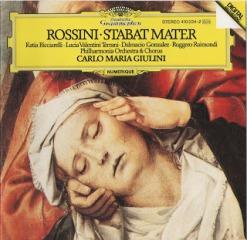Rossini - Stabat Mater (Giulini) [2007]
Rossini - Stabat Mater (Giulini) [2007]

1. 1. Stabat Mater dolorosa - 9:55 2. 2. Cujus animam gementem - 6:46 3. 3. Quis est homo qui non fleret - 7:17 4. 4. Pro peccatis suae gentis - 5:08 5. 5. Eja Mater fons amoris - 4:51 6. 6. Sancta Mater istud agas - 8:46 7. 7. Fac ut portem Christi mortem - 5:07 8. 8. Inflammatus et accensus - 5:17 9. 9. Quando corpus morietur - 5:44 10. 10. Amen - 5:53 Katia Ricciarelli - soprano I Lucia Valentini Terrani - soprano II Dalmacio Gonzalez - tenor Ruggero Raimondi - bass Philarmonia Chorus Philarmonia Orchestra Carlo Maria Giulini – conductor
There's no doubting Gioachino Rossini's sincerity in his Stabat Mater -- he himself was so moved by the piece that he couldn't bear to attend the work's dress rehearsal or any of its first performances -- but still, his setting of the Latin text is, strictly speaking, only a sacred work. With its heightened drama, its passionate lyricism and its histrionic virtuosity, it is actually an emotional work, a work in which the composer takes the Latin text as an opportunity to demonstrate its feelings on the subjects of grief and death. As this profoundly serious 1982 performance led by Carlo Maria Giulini proves, this doesn't mean Rossini didn't honestly feel his feeling: it means that he objectified them by transforming them into art. With the clarion twin sopranos Katia Ricciarelli and Lucia Valentini Terrani in the duet "Quis est homo," the rugged bass Ruggero Raimondi in the aria "Pro peccatis suae gentis" and particularly the heroic tenor Dalmacio Gonzalez in the showpiece aria "Cujus animam gementem," Giulini has a cast ready to pour their hearts into the music, and with the firm support of the Philharmonia Orchestra and Chorus, he creates a musical funeral monument that strikes fear and pity into the hearts of listeners. Deutsche Grammophon's early digital sound is big, bold, and only sometimes bombastic. ---James Leonard, Rovi








